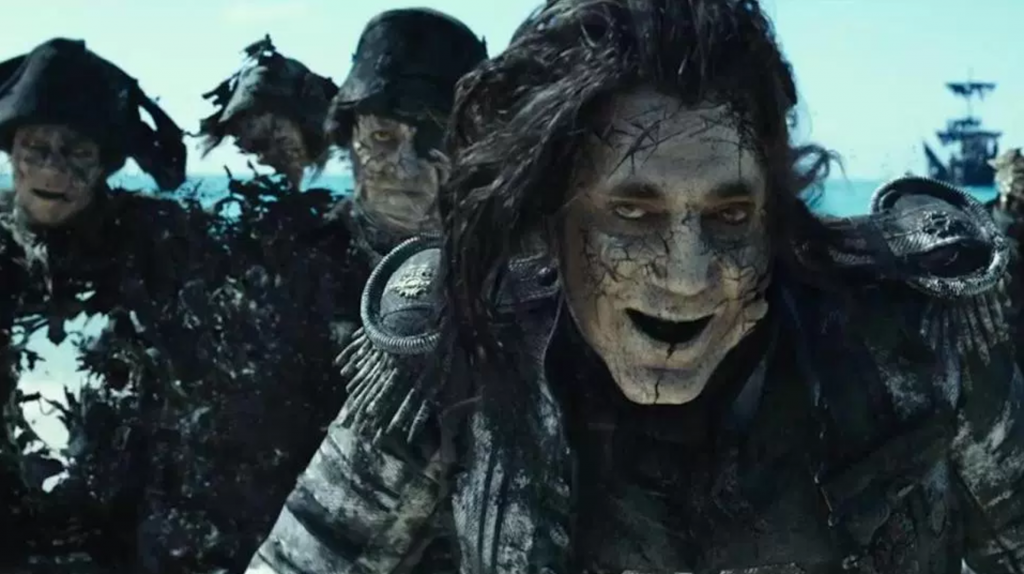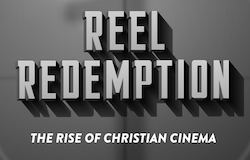Shiver Me Timbers! by Mark Matich
24 May
For this fifth outing, even fans of Disney’s venerable Pirates franchise may be sympathetic to the tongue-in-cheek boredom of the flamboyant swashbuckler Jack Sparrow as he introduces himself to the uninitiated characters in the film, a plucky pair of youthful protags. Despite the generally underwhelming response to two most recent films in the series (2007’s At World’s End and 2011’s On Stranger Tides), there is no doubt that, with his portrayal of the lovably wily Sparrow, Johnny Depp has created one of the more enduring cinematic characters of the twentieth-first century. It would be easy enough to fashion another film around his antics, but thankfully a fresh directing duo, Joachim Rønning and Espen Sandberg, working from veteran adventure film screenwriter Jeff Nathanson’s (Indiana Jones and the Kingdom of the Crystal Skull) script, manage to add some enjoyable new dimensions, at least aesthetically, to the proceedings.
The two Norwegian directors by no means tyros, having already mounted the impressive large-scale seagoing saga Kon Tiki together and collaborated as directors of several episodes of Netflix’s Marco Polo. They manage to keep things moving along briskly, and in not deviating too far from the central narrative to get sidelined into subplots involving Devil’s Triangles, fantastical sea monsters, and interminable tavern scuffles, have brought together one of the leaner entries in the series pacing-wise. Refreshingly, it seems as though they don’t feel tasked with the fact they have to go through the motions to some extent, in the way Depp knowingly winks at the audience in the manner I mentioned earlier. Instead, they embrace the idea that a by-the-numbers sequel can be spruced up in the way those “numbers”, in the musical-film sense, are handled. What I mean by this is, they realize it is to their advantage we already know Jack will be our boozy, woozy anchor into the story. In this case it is a quest for Poseidon’s Trident, which will free Will Turner from a curse put on him in one of the earlier entries. We get just enough background on Will’s son Henry (Brenton Thwaites), and his initially reluctant, highly resourceful female accomplice Carina Smyth (Kara Scodelario) to integrate them into our understanding of the Pirates mythos, and along with almost all the major players from the series reprising their earlier roles, the newcomers offer game performances.
Like all successful later installments of series, the task that has to be met, and I think that has been met to an admirable degree here, is not to strain to flesh out characters we already know. This necessary predictability in characterization is an aspect of films like Aliens, Back to the Future III, and the The Fate of the Furious (with the exception of Dom, who of course only changes superficially) that makes them work, whereas the aggressive tonal shifts in Spider-Man 3 spelled doom for that film’s reception. In a film like this, with characters that are already iconic and a plot that it would be counterintuitive to make too complicated, the real challenge is, to put it bluntly, to dazzle with set pieces for two hours or so. I know this sounds like it’s coming straight from an inter-office memo from Bruckheimer. But if one looks at most of the great action adventure films, even back to King Kong, Gunga Din, and, of course, The Sea Hawk, and Mutiny on the Bounty, the great-grandfathers of films like Pirates of the Caribbean, set pieces are their bread and butter.
And I’m happy to say that in this department the filmmakers, including cinematographer Paul Cameron, do not disappoint. The brashness and even scariness of some of the action balances the goofy nautical humor that is the series’ trademark, which is also, by the way, one of the more on-target aspects of Nathanson’s screenplay. We are treated to the fending off of ghost sharks, about a dozen near-misses with a guillotine, and the menacing Captain Salazar, another broad villain role essayed with relish by Javier Bardem. There is a bit of lag in the storytelling in the film’s midsection, with a number of talky scenes that break my cardinal rule by getting bogged down in cryptic backstory. But it regains its sea legs for a truly astonishing last act, with a foregrounding of the film’s excellent use of 3-D. (The center of the frame is used programmatically, with shots being filmed strategically from behind or directly in front of objects in the central foreground, and then complementing this by creating a sense of depth in other scenes by pinning one or two objects on the sides of the frame close to the camera, for those who care about this sort of thing.)
The more I go to see “big” movies, the so-called tentpole titles, the more I realize that the at-times-crippling cynicism of the day has inured the moviegoing public into the fact they can be quite good given the right treatment. Embarrassingly, at one of the other films I saw recently, Snatched, the audience had to sit through a pre-film PSA imploring them to keep coming to the theater. Here, Rønning and Sandberg make no bones about the fact they are making a good, old-fashioned swashbuckler, a superproduction of the scope and confidence that it needs no such accompaniment. And that’s fine with me. This is for fans of the series and outsized popcorn films, and “all others need not apply”… unless the vicarious need for bold adventure on the high seas should strike suddenly.




No comments yet